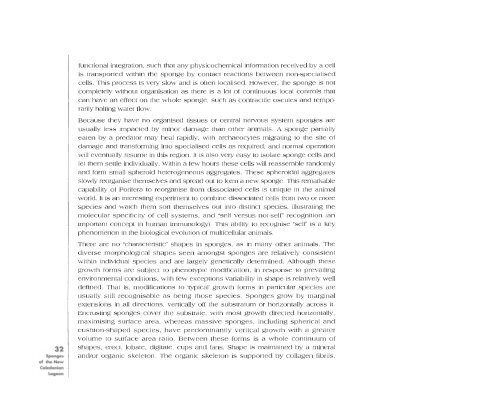Sponges of the New Caledonian lagoon - IRD
Sponges of the New Caledonian lagoon - IRD
Sponges of the New Caledonian lagoon - IRD
Create successful ePaper yourself
Turn your PDF publications into a flip-book with our unique Google optimized e-Paper software.
32<br />
<strong>Sponges</strong><br />
<strong>of</strong> <strong>the</strong> <strong>New</strong><br />
<strong>Caledonian</strong><br />
logoon<br />
functional integration, such that any physicochemical information received by a cell<br />
is transported within <strong>the</strong> sponge by contact reactions between non-specialised<br />
cells. This process is very slow and is <strong>of</strong>ten localised. However. <strong>the</strong> sponge is not<br />
completely without organisation as <strong>the</strong>re is a lot <strong>of</strong> continuous local controls that<br />
can have an effect on <strong>the</strong> whole sponge, such as contractile oscules and temporarily<br />
halting water flow.<br />
Because <strong>the</strong>y have no organised tissues or central nervous system sponges are<br />
usually less impacted by minor damage than o<strong>the</strong>r animals. A sponge partially<br />
eaten by a predator may heal rapidly, with archaeocytes migrating to <strong>the</strong> site <strong>of</strong><br />
damage and transforming into specialised cells as required, and normal operation<br />
will eventually resume in this region. It is also very easy to isolate sponge cells and<br />
let <strong>the</strong>m settle individually. Within a few hours <strong>the</strong>se cells will reassemble randomly<br />
and form small spheroid heterogeneous aggregates. These spheroidal aggregates<br />
slowly reorganise <strong>the</strong>mselves and spread out to form a new sponge. This remarkable<br />
capability <strong>of</strong> Porifera to reorganise from dissociated cells is unique in <strong>the</strong> animal<br />
world. It is an interesting experiment to combine dissociated cells from two or more<br />
species and watch <strong>the</strong>m sort <strong>the</strong>mselves out into distinct species, illustrating <strong>the</strong><br />
molecular specificity <strong>of</strong> cell systems, and "self versus not-self" recognition (an<br />
important concept in human immunology). This ability to recognise "self" is a key<br />
phenomenon in <strong>the</strong> biological evolution <strong>of</strong> multicellular animals.<br />
There are no "characteristic" shapes in sponges. as in many o<strong>the</strong>r animals. The<br />
diverse morphological shapes seen amongst sponges are relatively consistent<br />
within individual species and are largely genetically determined. Although <strong>the</strong>se<br />
growth forms are subject to phenotypic modification, in response to prevailing<br />
environmental conditions, with few exceptions variability in shape is relatively well<br />
defined. That is, modifications to 'typical' growth forms in particular species are<br />
usually still recognisable as being those species. <strong>Sponges</strong> grow by marginal<br />
extensions in all directions, vertically <strong>of</strong>f <strong>the</strong> substratum or horizontally across it.<br />
Encrusting sponges cover <strong>the</strong> substrate, with most growth directed horizontally,<br />
maximising surface area, whereas massive sponges. including spherical and<br />
cushion-shaped species, have predominantly vertical growth with a greater<br />
volume to surface area ratio. Between <strong>the</strong>se forms is a whole continuum <strong>of</strong><br />
shapes, erect, lobate, digitate, cups and fans. Shape is maintained by a mineral<br />
and/or organic skeleton. The organic skeleton is supported by collagen fibrils,

















